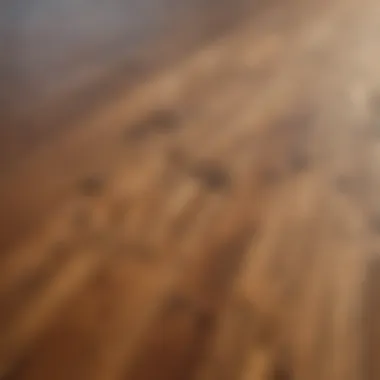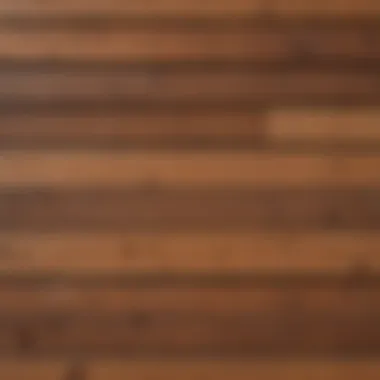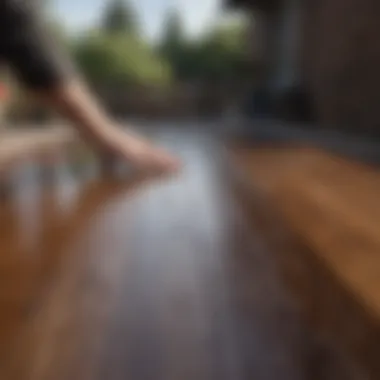Choosing the Right Semi-Transparent Deck Stains


Intro
When it comes to maintaining the beauty and functionality of a wooden deck, selecting the right semi-transparent deck stains and sealers is a vital task. With wood being one of the most popular materials for outdoor spaces, understanding how to protect it from the elements can significantly extend its lifespan and enhance its charm. Semi-transparent stains allow the natural grain of the wood to shine through, while providing protection against moisture, UV rays, and everyday wear and tear. This combination not only appeals to the aesthetic senses but also is practical, promoting durability and longevity in your outdoor investments.
Importance of the Topic
The significance of selecting appropriate semi-transparent deck stains and sealers cannot be overstated. For homeowners, investing time and money into the upkeep of their decks pays off in two main ways: first, by preserving the appearance and integrity of the wood, and second, by ensuring a safe and enjoyable outdoor space for gatherings and relaxation. Failing to apply a quality stain or sealer can lead to rapid degradation, leading to peeling, fading, or worse, structural damage. In a world where aesthetics and functionality go hand in hand, understanding the nuances of these products is not just beneficial, but essential for maintaining the outdoor allure of one’s home.
Understanding Semi-Transparent Deck Stains
When it comes to caring for your deck, understanding semi-transparent deck stains is crucial. Not only do they enhance the wood's appearance, but they also offer protection against the elements. As a homeowner, you want your outdoor space to be as inviting and durable as possible. Semi-transparent stains provide the perfect balance between showcasing the natural beauty of the wood and providing essential protection from sun, rain, and foot traffic.
Definition of Semi-Transparent Deck Stains
Semi-transparent deck stains are a type of finish that allow the wood grain to show through while providing color. This feature is great for people looking to maintain the natural appearance of the deck while also adding a hint of color. They differ from solid stains which cover the wood completely and from clear sealers that offer no tint. Semi-transparent stains penetrate the wood fibers, giving it a textured look and a soft sheen that catches the eye.
Visibility of the wood grain and texture makes semi-transparent stains appealing. They come in various hues, from earthy browns to vibrant reds and even deep grays. Selecting the right shade can dramatically change your deck’s aesthetic, making it cozy or contemporary—depending on your taste.
Key Characteristics of Semi-Transparent Stains
Understanding the key characteristics of these stains helps homeowners select the right product. Here are some notable features you should consider:
- Wood Grain Visibility: Unlike solid stains, semi-transparent options allow the wood grain to be visible, highlighting its unique patterns.
- Color Variety: With a wide array of colors available, you can choose shades that match your home and landscape.
- UV Protection: These stains typically contain UV blockers, which help prevent the wood from fading in the sunlight, extending its lifespan.
- Water Resistance: Most semi-transparent stains offer water-repellent properties, which protect the wood from damage caused by moisture.
- Longevity: While not as long-lasting as solid stains, quality semi-transparent options can provide several years of protection if properly maintained.
"Choosing a stain isn’t just about color; it’s about extending the life of your deck."
In summary, semi-transparent deck stains are a worthy consideration for maintaining your outdoor space. Their ability to enrich wood’s natural beauty while offering vital protection makes them appealing to those who wish to combine aesthetics with practicality. Taking time to understand what they are, and their core features will help in selecting the best option tailored to your deck and environment.
The Importance of Deck Maintenance
Maintaining a wooden deck is not just about making it look nice in the backyard. It’s about protecting your investment while ensuring that the space remains safe and usable for years to come. While it’s tempting to skip this step—especially when you’re busy with family and household duties—skipping maintenance can lead to significantly more work down the line. So whether it’s rain, snow, or the blazing sun, your deck's surface takes hits all year long. Regular upkeep is essential in keeping it sound.
Why Staining and Sealing Matter
Staining and sealing are crucial for several reasons:
- Protection Against Elements: Stains and sealers act like armor against the weather. They protect wood from water damage, which can lead to rot and mold. When water soaks into the wood, it doesn't just weaken it, it can also create an environment for fungi.
- Enhancing Beauty: A good stain can bring out the natural grain of the wood, turning a lackluster deck into a stunning outdoor haven. Choosing the right color can complement your home’s aesthetics, thus increasing its overall charm.
- Longevity: Regularly maintaining your deck can extend its lifespan significantly. A well-stained deck will generally last longer than one that’s ignored. Think of it like a car—if you neglect the oil changes and maintenance, it's going to wear out faster.
- Preventing Costly Repairs: Early intervention often saves you from hefty expenditures down the road. Spending a few dollars now on maintenance can prevent you from needing to replace rotten boards or reconfigure structural issues later on.
- Safety: A deck that’s well-maintained is also safer. Slippery surfaces from algae growth or splintered wood can cause serious injuries. Keeping your deck in good condition minimizes these risks.
In short, attention to your deck through staining and sealing is not just about aesthetics; it’s a matter of practicality.
Consequences of Neglecting Deck Care
Neglecting deck maintenance can lead to a heap of problems that could have been avoided. Here are some of the more common mistakes homeowners make:
- Moisture Damage: Without proper sealing, moisture can seep into the wood, leading to rot. Once that starts, it can spread like wildfire, affecting adjoining boards and the frame underneath.
- Pests: Wood exposed to moisture becomes a welcome mat for pests like termites. These critters can destroy your deck from inside out, leading to costly removals.
- Aesthetic Decline: An unmaintained deck soon loses its luster. Over time, the wood can fade and gray, leading to a drab appearance that no amount of furniture can fix. Your outdoor haven becomes an eyesore, detracting from your home’s appearance.
- Health Hazards: As mentioned earlier, algae and mold can thrive in moisture-laden decks. This creates slippery surfaces which could lead to falls and injuries. Additionally, mold spores can be harmful if inhaled.
- Budget Blowouts: As repairs pile up, your budget could be stretched thin. Fixing problems can become much more expensive than simply carrying out routine maintenance.
In essence, while skipping out on deck care might feel like a little luxury, it’s a gamble that often doesn't pay off. Keeping on top of everything, like staining and sealing, ensures that you’ll have a beautiful and safe space to enjoy with loved ones for years to come.
"An ounce of prevention is worth a pound of cure."
Neglecting a simple stain job can turn your picturesque deck into a deteriorating structure, affecting both its functionality and the value of your home. Make sure to set a routine for upkeep and boost your deck's durability and appearance.
Factors to Consider When Choosing a Semi-Transparent Stain
Choosing the right semi-transparent stain for your deck is not a matter of whim; it’s about strategic planning and informed choices. Your deck's overall lifespan, aesthetic appeal, and the maintenance burden it will carry depend significantly on this decision. Understanding the factors at play can help you make decisions that not only suit your style but also ensure the longevity of your wooden surfaces.
Every choice you make—whether it pertains to wood types, environmental conditions, or desired finishes—has its ramifications. Let’s dive deeper into each of these elements to shed light on the nuances involved in choosing a semi-transparent stain.
Wood Type and Its Impact on Stain Choice
The type of wood your deck is constructed from plays a pivotal role in what stain you should choose. Different woods have varying porosities and textures, which can influence how they absorb products.
- Softwoods like pine and cedar typically soak up stain more readily than hardwoods, necessitating a stain that enhances their natural beauty without overwhelming their fine grain. This quality makes them a popular choice for a warm, inviting look.
- Hardwoods such as oak or mahogany are denser and might require a different approach. Stains made specifically for hardwoods usually provide deeper penetration and durability.
In essence, recognizing the wood type is foundational in ensuring the stain adheres well and achieves the desired effect. For example, if you're using redwood, opting for a stain designed for softwood can sometimes lead to disappointing results due to improper absorption.
"Choosing a stain that aligns with your deck's wood type can save you headaches down the road and ensure a better finish."
Climate Influence on Deck Stain Durability


Weather conditions around your home can impact the performance of your semi-transparent stain. It's not just about applying a product; it's about understanding how sun exposure, humidity, and temperature variations interact with the materials involved.
- Sun Exposure: For homes in sun-drenched locales, UV radiation can quickly break down stains, leading to peeling and fading. Here, opting for products with UV inhibitors can be wise.
- Humidity and Rainfall: If you live in a region marked by high humidity, a stain that can withstand moisture without molding or warping is paramount. Stains that form a barrier against water intrusion will significantly prolong the deck's life.
Various manufacturers often indicate the suitability of their products for different climates. Keeping an eye on these specifications ensures that you spend less time maintaining and more time enjoying your space.
Desired Aesthetic: Color and Finish Options
When it comes to aesthetics, semi-transparent stains offer a wide palette of colors, but the choices can easily become daunting. The finish you choose can fundamentally alter the deck's appearance and its integration with your home’s overall style.
- Color Variants: Some prefer light shades that provide an airy feel, while others may lean toward dark tones that add depth. Regardless of preference, test your selected stain on a small area first to see how it interacts with your wood’s natural hue.
- Finish Type: Semi-transparent stains come in various finishes—matte to gloss—that can either reflect light or absorb it. Selecting the right finish can enhance or detract from your deck’s overall vibe.
For housewives and homeowners aiming to keep their outdoor spaces chic yet practical, this consideration becomes a way to express personal style while ensuring longevity.
So there you have it—navigating the tricky waters of selecting a semi-transparent stain involves an intricate dance of various elements. Skip a step, and you might not only compromise the deck but also mar the beauty of your external habitat.
Comparing Popular Semi-Transparent Deck Stains
When it comes to preserving and enhancing the beauty of your deck, making the right choice between various stains can feel quite overwhelming. Each brand of semi-transparent deck stains presents a unique blend of features and benefits. Navigating through this sea of options is crucial because it not only influences the visual appeal but also determines the longevity and durability of the wooden surface. Thus, understanding the intricacies of these products can become a game-changer for homeowners.
Knowing which stain aligns with your specific needs can save you time, effort, and even money in the long run. Here, we will dissect the offerings from some of the most popular brands in the market, focusing on their unique selling points, performance metrics, and overall value. This comparison serves as a blueprint for making an informed choice tailored to your deck's particular requirements.
Brand A: Features and Benefits
Brand A has carved out a significant niche in the market with its wide array of semi-transparent deck stains. One of the standout features includes its water-repellent properties, which ensure that moisture does not seep into the wood, causing rot. Its formula also includes ultraviolet blockers to protect against fading and graying, making it an ideal choice for sunny locations.
- Features:
- Benefits:
- Water-repellent technology
- Ultraviolet protection
- Low-VOC options available
- Extends the life of the deck
- Maintains color vibrancy over time
- Environmentally friendly composition
These features make Brand A a favorite among those looking to maintain their deck’s aesthetics while ensuring it withstands the test of time.
Brand B: Product Highlights
Moving on to Brand B, this company is known for its ease of application and quick-drying formula. If you're someone who enjoys getting projects done relatively quickly, this could be a game-changer. Additionally, Brand B offers a variety of color choices that really allow homeowners to showcase their creative side.
- Product Highlights:
- Extra Perks:
- Fast-drying; typically within two hours
- User-friendly application process
- Extensive color palette, including custom colors
- Excellent coverage per gallon, making it cost-effective
- Suitable for various climate conditions
These qualities underscore why Brand B is the go-to for those who prioritize convenience without sacrificing visual appeal.
Brand C: Review of Performance
Last but not least, let’s take a closer look at Brand C. This brand often finds its way into the conversations among deck owners due to its superior durability. Users have reported that the stain remains intact for significantly longer periods compared to others, even in harsh weather conditions.
- Performance Highlights:
- Potential Downsides:
- Superior resistance to wear and tear
- Excellent adhesion on various wood surfaces
- High customer satisfaction rates based on reviews
- Slightly longer curing time
- Limited color range compared to competitors
Despite some minor drawbacks, Brand C continues to impress users with its exceptional performance, making it a reliable choice among those who want their investment to last.
In summary, comparing these popular semi-transparent deck stains helps to navigate the options effectively. Each brand has its own strengths, and understanding those can make all the difference in achieving a deck that not only looks good but also stands the test of time.
Application Techniques for Optimal Results
Applying semi-transparent deck stains and sealers correctly is not just a matter of aesthetics; it is crucial for enhancing the longevity of your deck. Effective application techniques can mean the difference between a stain that lasts for years and one that requires frequent reapplication. By understanding the proper methods for surface preparation, the right tools, and a systematic approach to application, homeowners can achieve vibrant and lasting results while protecting their wooden surfaces from the elements.
Surface Preparation: Essential Steps
Before applying any stain, surface preparation is vital. Failing to adequately prepare the surface can lead to poor adhesion, resulting in peeling and uneven color. Here are the essential steps to ensure your deck is ready for staining:
- Clean Thoroughly: Use a power washer or deck cleaner to remove dirt, mildew, and old stain. If mildew is present, a solution of bleach and water can help. Allow the surface to dry completely, which can take up to 48 hours depending on the weather.
- Inspect for Damage: Look for any rotting wood or loose boards. These areas must be repaired or replaced; otherwise, moisture can seep in, leading to further decay.
- Sand the Surface: Lightly sand the surface to create a smooth finish and remove any rough spots. This step is particularly important on older decks where weathering might have created splinters.
- Test for Moisture: Wood must be dry before staining. One way to test for moisture content is to sprinkle a few drops of water on the surface. If the water beads up, the wood is too dry; if it soaks in, then it’s ready for staining.
"Proper surface preparation is like priming a canvas; it sets the stage for a masterpiece."


Tools Required for Application
Having the right tools on hand makes the job smoother and more efficient. Below are the tools that every homeowner should consider having:
- Paint Roller or Brush: Choose between a high-quality brush for detail work and a roller for extensive areas.
- Stain Pad or Sprayer: A stain pad can provide great coverage with less mess. A sprayer can speed up the application but may require more clean-up.
- Drop Cloths: To protect the surrounding areas from drips and spills, use drop cloths or tarps.
- Safety Gear: Ensure you have gloves, protective eyewear, and a mask, especially if you’re working with chemicals.
- Bucket for Mixing: If you're using a concentrated stain, you’ll need a bucket for mixing the contents as per the product instructions.
Step-by-Step Application Process
Once the deck is prepared and you have the tools at your fingertips, it's time to apply the stain. Follow these steps for a successful application:
- Mix the Stain: Stir the stain thoroughly to ensure an even color throughout. Follow the manufacturer's instructions on dilution, if any.
- Start with Edges: Begin by applying stain to the edges and corners with a brush. This method ensures you cover areas that a roller may miss.
- Roll the Main Surface: Use a roller to cover the main deck area. Work in small sections, rolling the stain on in even strokes to avoid pooling and run-offs.
- Feather Out: Make sure to feather out the edges where you started and ended with the roller to avoid marks or lines.
- Drying Time: Allow the first coat to dry completely. Typically, it's advised to wait 24 hours before applying a second coat. Always consult the specific drying times on the product label.
- Apply Additional Coats: For full coverage and deeper color, a second coat can usually be applied.
By following these application techniques, homeowners can expect to see a beautiful, well-protected deck that stands the test of time. With careful attention to detail during both preparation and application, the stains will not just beautify but also extend the life of your decking.
Maintenance of Stained Decks
Maintaining stained decks is an essential aspect that many homeowners often overlook. While the initial application of semi-transparent stains may enhance the beauty of your outdoor space, neglecting regular maintenance can lead to significant issues down the line. Good maintenance does not just keep the deck looking sharp; it extends the life of the wood, protects against environmental damage, and ensures that you get the most out of your investment.
Here are some key reasons why looking after your stained deck is crucial:
- Aesthetic Appeal: A well-maintained deck preserves that freshly stained look, continuing to dazzle your guests and family.
- Life Span: Regular upkeep can greatly increase the longevity of the wood, saving costly replacements later on.
- Safety: Ongoing care can help prevent rot or decay, ensuring your deck remains safe.
- Property Value: An appealing and well-maintained deck can increase the overall value of your home.
By investing time and attention to upkeep, you're not just polishing a surface; you're nurturing an extension of your living space.
Regular Maintenance Schedule
Creating a regular maintenance schedule is a best practice for homeowners with stained decks. Such a routine helps catch minor issues before they escalate into major problems.
It might sound a bit tedious, but a little planning can go a long way:
- Initial Inspection: Right after you've stained the deck, evaluate its condition every month for the first few months to see how well the finish holds up.
- Quarterly Check-ups: Post the first few months, a seasonal check every three months can be beneficial. Look for fading, peeling, or signs of wear and tear.
- Thorough Cleaning: At the start of each new season, clean the deck with a mild detergent and a soft brush to prevent the buildup of dirt, mold, or mildew. This helps the stain adhere better during the next application.
- Re-staining Schedule: Depending on the climate and wear, reapply a semi-transparent stain every 2-3 years, but keeping a close eye on its condition will help you know the best time for this.
Signs of Wear and When to Reapply
Knowing when to reapply stain is indispensable for preserving the deck's durability and aesthetic. Here are some clear signs that indicate your deck may need a fresh coat:
- Fading Color: If the vibrant hues of your stain start to look dull, it is usually a sign the stain has lost its effectiveness.
- Peeling or Blossom Formation: If you notice any flaking or peeling areas, it suggests the stain is failing, and moisture may penetrate the wood, leading to further damage.
- Water Absorption: An easy test is to sprinkle some water on the deck. If it absorbs quickly, it indicates that the stain is wearing off, and it's time to consider reapplication.
- Mold or Mildew Growth: If you see mold or mildew, it often means the protective barrier of the stain has been compromised.
"Regular attention to your stained deck can turn small maintenance tasks into a smooth sailing chore, rather than a frantic rescue mission."
Keeping an eye on these indicators and establishing a proactive approach for maintenance will ensure that your deck remains not just a beautiful place to relax, but also a safe and sustainable part of your home.
Environmental Considerations in Deck Staining
Staining your deck isn’t just a matter of aesthetics; it’s about making choices that respect and preserve the environment. The materials you select can have a lasting impact on both your outdoor space and the broader ecosystem surrounding it. Being mindful of the ecological footprint of deck staining can lead to benefits that extend further than simply a well-finished surface. It’s crucial to consider the ingredients in the products we choose, knowing they can interact with the flora and fauna nearby.
Eco-Friendly Stain Options
When you’re on the hunt for a deck stain, consider eco-friendly alternatives that serve both function and sustainability. Many brands now offer products labeled as low-VOC, or volatile organic compounds, which means these stains release fewer harmful chemicals into the air. Selecting products that pride themselves on natural ingredients can not only protect your health but also minimize environmental risks.
Here are a few eco-friendly options to consider:
- Plant-Based Stains: Stains made from natural oils and extracts often result in vibrant, rich colors while being safer for the environment. Linseed oil and soy oil are common base materials in these types of stains.
- Water-Based Stains: These stains are known for their lower VOC levels. They generally dry quicker and several brands create formulas that provide durable coverage without harsh chemicals.
- Recycled Products: Some manufacturers produce stains from recycled materials. This approach reduces waste and promotes sustainability, all while ensuring a fashionable finish to your deck.
As you explore eco-friendly stains, it’s a good habit to closely read labels and seek products with credible, environmentally-friendly certifications.
Impact of Chemicals on Surrounding Flora and Fauna
The chemicals used in conventional stains can seep into the ground and waterways surrounding your deck. This toxic runoff can have adverse effects on plants, animals, and even local water quality. Understanding these impacts is vital for anyone looking to maintain a healthy backyard ecosystem.
- Negative Effects on Plants: Many standard deck stains contain harmful ingredients that can hinder plant growth. If these substances leach into the soil, they can disrupt the health of nearby plants, potentially leading to wilted leaves or stunted growth. Even a beautiful garden could suffer as a result.
- Harm to Wildlife: Chemicals present in deck stains can be dangerous for birds, insects, and mammals that might come into contact with them. For example, bees are particularly sensitive to various compounds. If they’re affected, it can disrupt local pollination and lead to broader ecological challenges.
- Water Contamination: Simultaneously, runoff from treated decks could enter storm drains and rivers. This further exacerbates pollution, affecting larger bodies of water and the aquatic life that inhabits them. Fish and other aquatic organisms can be especially sensitive to these chemicals, risking their populations and the overall health of the ecosystem.
"When it comes to deck care, it’s smart to think globally while acting locally. Every small decision counts."
In summary, choosing the right stains and sealers not only protects your deck but also aids in safeguarding the environment. Making informed decisions in this regard can pay off in spades, ensuring that your deck is both a joy to own and a refuge for the surrounding wildlife.
Exploring Alternative Deck Finish Options
When considering the best methods to protect and enhance the appearance of your wooden deck, it’s essential to explore the options beyond semi-transparent stains and sealers. Delving into alternative deck finishes can uncover numerous benefits that might better suit your specific needs. This section sheds light on the significance of these alternatives, their unique characteristics, and what to keep in mind when making a choice.
Opaque Stains vs. Semi-Transparent Stains


When it comes to deck finishes, the difference between opaque and semi-transparent stains can greatly influence the overall appearance and longevity of your deck. Opaque stains provide a solid color and hide the wood grain completely. This can be beneficial if the wood has blemishes or an unattractive grain pattern. Moreover, because these stains offer superior UV protection, they may be better for decks that see intense sunlight.
On the other hand, semi-transparent stains allow the wood grain to show through, adding richness and depth to the wood’s natural beauty. These stains are often favored for their balance between aesthetics and protection. However, they generally need more frequent reapplication compared to opaque options due to wear and weathering.
It’s crucial to weigh the advantages:
- Opaque Stains:
- Semi-Transparent Stains:
- Offers complete coverage of imperfections.
- Greater UV resistance leads to less fading.
- Typically longer intervals between applications.
- Preserves the natural beauty of the wood.
- Greater color choice, allowing for a more personal touch.
- Easier to touch up in specific areas without a complete recoat.
In the end, the choice will depend on what look and level of maintenance you are willing to commit. Each option has its pros and cons that suit different preferences and decks.
Natural Oils and Their Advantages
Natural oils such as teak oil or tung oil present yet another avenue for deck finishes. These oils penetrate deeply into the wood fibers, providing excellent nourishment while maintaining the natural appearance of the wood. Some advantages include:
- Enhanced Wood Grain: Oil finishes illuminate the natural texture and beauty of the wood without masking it.
- Water Resistance: Natural oils create a barrier against moisture penetration, thus reducing the risk of rot and decay.
- Easy Maintenance: Unlike traditional paints and stains, these oils can often be reapplied without extensive preparation. A quick wash and a fresh coat can suffice in many cases.
- Eco-Friendly Options: Many natural oils are derived from renewable sources and contain fewer harsh chemicals compared to synthetic options, making them a greener choice for environmentally-conscious homeowners.
"The best finish is the one that fits your wood type, environmental conditions, and personal preferences."
By understanding the landscape of your choices, you can ensure that your deck not only stands out but withstands the tests of time.
Common Misconceptions About Deck Stain and Sealer Choices
When it comes to choosing deck stains and sealers, many homeowners fall victim to several common myths. These misconceptions can significantly affect both the choices made and the longevity of the wood, ultimately impacting the overall enjoyment of outdoor spaces. Understanding these misunderstandings not only aids in making informed decisions but also enhances one's ability to maintain wooden decks properly. This section elucidates some of the prevalent myths surrounding deck stains and sealers, aiming to clear the fog and guide homeowners toward the appropriate product choices.
Myths Surrounding Durability
A frequent misconception is that all deck stains offer the same level of durability. Many people assume that a more expensive stain is guaranteed to last longer than a budget-friendly option. However, durability hinges on various factors, including formulation and environmental conditions.
For example, oil-based stains tend to penetrate deeply into the wood, offering a robust layer of protection, while water-based stains might require more frequent applications but dry faster. It’s not merely about the price tag; the specific wood type, the climate where one lives, and even the amount of foot traffic on the deck can influence how well a stain performs over time.
"Understanding the unique requirements of your deck can help you choose the right product, ensuring you enjoy your outdoor space for years to come."
Preconceptions About Color Options
Another prevalent misconception is that lighter stains won't provide enough protection compared to darker options. People often believe that the darker the stain, the better the shielding from UV rays and moisture. While it's true that darker pigments can absorb UV rays, lighter semi-transparent stains can also provide adequate protection if properly maintained.
Aesthetics play a massive role in color choice, and many homeowners are misled into thinking that a single shade will pigeonhole them into a specific look. In reality, semi-transparent stains offer a spectrum of hues, allowing for creativity while ensuring the natural beauty of the wood grain shines through. You can choose a color that harmonizes with your home’s exterior without sacrificing effectiveness.
In summary, debunking these myths allows homeowners to embark on their deck improvement journey armed with knowledge, clarity, and confidence.
Consulting Experts: When to Seek Professional Help
Taking care of a deck is no small feat. While many homeowners may feel up to the task of applying semi-transparent stains and sealers, there are junctures when the expertise of professionals becomes not just beneficial, but essential. Understanding the signs that indicate when to bring in an expert can save time, money, and headaches. What’s more—the peace of mind that comes with having a knowledgeable hand can truly transform your deck's longevity and look.
Signs Your Deck Requires Professional Attention
It’s not always easy to tell whether your deck is in tip-top shape or if it’s waving a red flag. Here are some indicators that might suggest you could use an expert’s touch:
- Visible Damage: Cracks, splinters, and warped boards are glaring signs your deck needs help. A professional can assess whether repairs are enough or if replacement is in order.
- Fading or Discoloration: If your deck’s color is fading or there are noticeable patches where the stain has worn off, it may be time to consult someone with experience in deck restoration. Professionals often carry the right tools and products for even coverage.
- Mold or Mildew Growth: Not only can this affect the appearance of your deck, but it can also promote decay. If you notice mold creeping in, hiring an expert who can properly treat and seal it is best.
- Peeling or Chipping Stains: This could be a sign of improper application of previous stains. Hiring a professional can ensure that the correct techniques and products are used to achieve a durable finish.
- Excessive Wear and Tear: If the deck sees heavy use or is subjected to harsh weather conditions, a professional assessment can help determine the right maintenance approach.
If you notice these signs, don’t hesitate to reach out for assistance. An ounce of prevention can save you a pound of cure.
Finding Reputable Deck Finishing Services
When it comes to hiring help for your deck, finding the right service can be a daunting task. Here are some tips to help you find professionals that tick all the right boxes:
- Research Online: Platforms like Reddit can be goldmines for finding local services with honest reviews. Make use of community feedback and get a sense of who has a solid reputation.
- Ask for Referrals: Word of mouth can be your best friend. Chat with neighbors or friends who have had deck work done. They might have recommendations based on experience that you can trust.
- Check Credentials: Always look for licensed and insured contractors. This protects you from liability in the event of accidents during the work.
- Get Multiple Quotes: Don't settle for the first option. By getting several quotes, you’ll not only have a clearer idea of pricing but also gauge the professionalism of each contractor—how they communicate can say a lot.
- Inquire About Their Approach: A reputable service should be willing to discuss their methods openly. Ask questions about the products they use and the processes they follow to ensure quality workmanship.
“A well-kept deck is a reflection of a well-kept home.”
The End: Making Informed Decisions
In the end, knowing how to approach the selection of semi-transparent deck stains and sealers makes all the difference. It's not just about tossing some pigment on wood and calling it a day; you’re essentially protecting an investment while also enhancing the beauty of your outdoor space. Here, the weight of informed choice bears down heavily. A strategic decision can lead to years of satisfaction and minimize the need for costly repairs or reapplications.
When you understand the various factors that go into selecting a stain – like wood type, local weather conditions, and desired appearance – you’re setting yourself up for success. If you choose the right product, you allow your deck to breathe and shine, showcasing the natural grain of the wood, and standing resilient against the elements.
- Quality matters: Going for well-regarded brands often means better durability and easier application, saving time and headaches down the line.
- Education is key: Staying informed about the upkeep, such as understanding when signs of wear appear, or when it’s time to reapply, equips you with knowledge that will prolong the life of your deck.
- Green options are available: Consider selecting eco-friendly stains that not only safeguard your wood but also keep your outdoor environment in mind.
"A well-treated deck is like a well-dressed house; it reflects your style and care for your home."
Embracing the nuances of these products will lead you to make suitable choices. It’s recommended to consult online resources or perhaps local experts who can provide insights specific to your own climate and wood type. Engaging with forums like those on Reddit can also be useful, as homeowner experiences often yield nuggets of wisdom. Each piece of information gathered plays a role in steering you clearer of decisions that may not serve you well.
By keeping your eyes and ears open, and being mindful of the specific characteristics of stains and sealers, you'll ensure that your deck not only remains functional but also continues to be a cherished part of your home for many seasons to come. The investment you make in choosing wisely speaks volumes about the care you put into your property.







